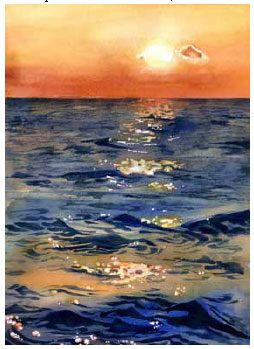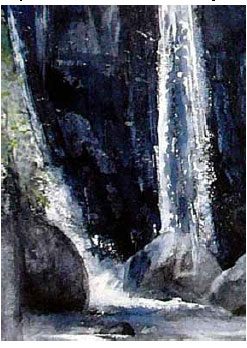Water is one of the most fascinating subjects you can paint.
It seems almost to have moods; it can ripple gently, or can plummet down a cliff, be so still that it reflects objects like a mirror, or crash and break on a shore.
Because water is so varied in its behavior, there is no one way to paint it. Rather, your best chance of success is to closely observe, and then try to make the watercolor paint act the same way on the paper.
So, when the water pools, your paint should pool. When it is active and flinging droplets around, your paint should do the same.
After close observation of the water, you’ll typically see three layers: the base color, the reflection, and the objects below the water.
When the water is moving quickly, the white highlights will dominate and may only show a streak or two of the blues and grays of the base color.
But in any case, you should paint water with these layers in mind. Don’t try to paint all three at once, or you’ll get a muddy mess.

Instead, paint the base color first and let that dry. If there are many whites as in a waterfall scene, you should avoid the whites and paint the base color around them.
If there are just a few white sparkles, as in the sunset ocean scene, protect them with masking fluid before you start painting.
You can either do this by carefully painting each sparkle, or by flinging the masking fluid on with a toothbrush or old brush; just make sure to wash it out with soapy water RIGHT AWAY or you won’t be using that brush again.

If the shadows are definite shapes on the underside of each ripple, you’ll have the greatest success by painting them after the base color has dried.
If, however, the lights and darks mix together freely, paint them on when the base is still slightly wet.
For a realistic effect, try using a syringe to drop color directly on the paper, then tilt the board and use a spray bottle to move the color around.
Water is always going to be challenging, but you’ll have more success when you let the paint and water do most of the work for you.
Salt, scratching, and using dry-brush techniques can all be used to develop textures, so take time to experiment.

A seascape is a landscape drawing that features the ocean and elements along the shore of the ocean.
Seascapes have been the subject of drawings and paintings for generations but recently it seems to be a hidden gem that is forgotten by budding artists.
Drawing seascapes offer challenges and artistic possibilities that make them ideal subjects for artists of all levels.
Artists who do attempt this form of drawing usually get caught up on focusing on the wrong elements which makes it hard to get a life like portrait.
Once you know the elements that will make or break your seascape you will never look back and will have more confidence in your ability.


